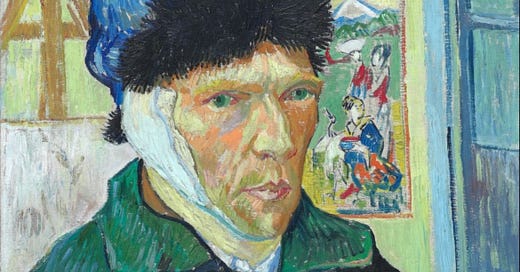He cut his ear off. It hit me like a ton of bricks as a third grader. The folklore of it all became intoxicating for my young mind. He cut his fucking ear off…
He died 91 years before I was born, a single lifetime between us. That was also a fact I would later on become fascinated with. His life ended at 37. He averaged 4 paintings a day for 10 years straight. 900 paintings in 10 years, though the math doesn’t add up as most historians site he could paint roughly one a day. That made me feel sophomoric, weak, a wannabe… Well played Vincent, I can’t keep up. Did he cut his ear off??? That’s up for debate like the law of averages. Is it all just a great story? Was he actually normal? Quite mortal? Quite averagely prolific?
I’ll never escape the image of The Olive Tree. A third grader, in a sea of fellow snot nose children staring into something quite the opposite of a starry night, totally oblivious to the weight of art. I stood there, and even some 35 years later, I can recall the impact of seeing the actual brush strokes of Van Gogh himself. The facts didn’t matter, the art captivated a new life long obsession. I, was an artist.
I didn’t know it at the time, but my life had changed because of Van Gogh. I wouldn’t understand it until decades later, standing in front of 300 kids answering questions that were delivered faster than the thought process it took conjure them. “Who’s your favorite artist?”, an oddly familiar snot nosed child chirped out of turn. I didn’t have an answer, I honestly hate that question, but my knee jerk reaction in the midst of the rapid fire barrage of childlike deposition was Vincent. A full circle realization served up by the curiosity of what could have been me, 35 years ago.
It’s not even his art that really captivated my attention all these years, it’s the fact that he somehow managed to matter long after his death. Therein lies one of the more inexplicably powerful aspects of art. In my opinion, it wasn’t the paint, it was the person. The story. The way the audience resonated a century later. The pain. The turmoil. The artist.
The effect Van Gogh had on me wasn’t one of visual arts, it was more about what art offered. These visual documentations of self. His blood flowed for 37 years, but the story still held strong a hundred some years later. More so, it only grew. Hundreds of millions of dollars worth of story and lore. To stand in front The Olive Tree and feel the irony and pain, what he saw, and what the world has done with how he saw it. I was drawn to the power of the art, not the stroke of the brush. There’s a selfish place for the process of making art, but I felt the pull of the story. I applied that to everything in my life, perhaps unintentionally, the equity of the story. But as I stood there, recounting my third grade Van Gogh experience to a third grader, I realized I was there with that audience not because I could paint a pretty picture, but because the pretty picture was just the introduction to my own story. And the pretty picture was an invite to tell it. They don’t come to see your line work, your brush strokes, they come to feel your view.
I’m not actually a Van Gogh fan. As it turns out he isn’t my favorite artist. The depression and the pain of it all lives in my mind like an old box of thoughts that wasn’t invited to the party.
I live just few miles away from The Olive Tree to this day. I often find some strange comfort knowing that late at night, when the lights are out at the Minneapolis Institute of Art, just a few blocks down the street a little piece of Van Gogh is resting up for the next day. On the days when I’m trying to make sense of it all I’ll go visit. I never stand directly in front of the painting, I like to watch the impact. I stand off in the corner and watch the power of the Van Gogh effect. Is it the beauty of the his view that mesmerizes, or is it the gunshot wound to the stomach that churns our curiosity?
That’s the Van Gogh Effect. He cut his fucking ear off…
-Mark Rivard




